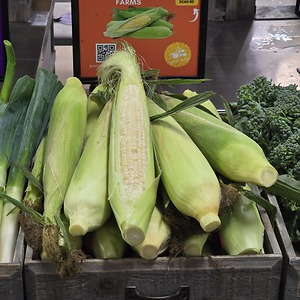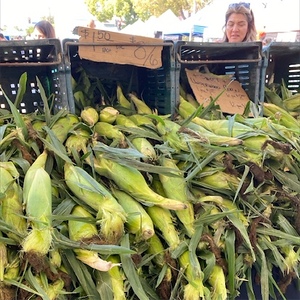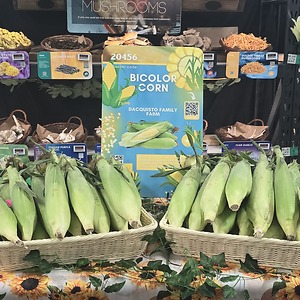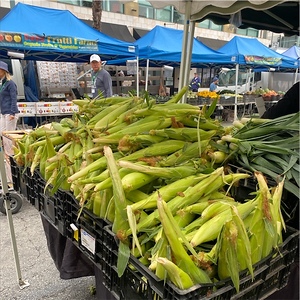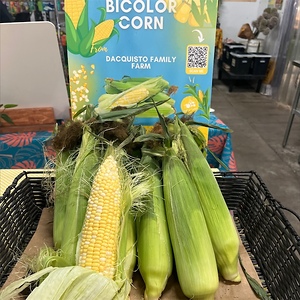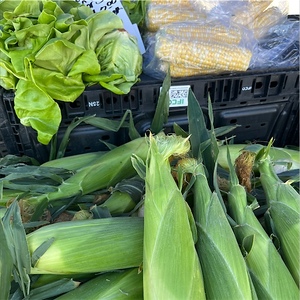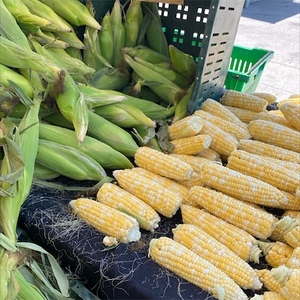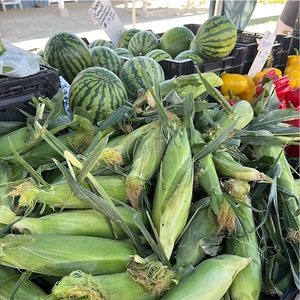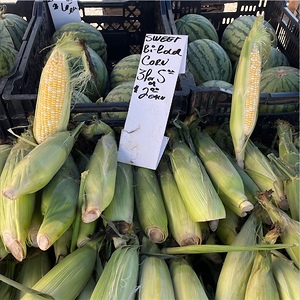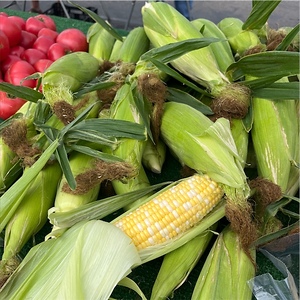


Bi Color Corn
Estimated Inventory, cs : 0
Description/Taste
Bicolor corn has an elongated, cylindrical shape, averaging 18 to 22 centimeters in length, and is encased in layers of dark to light green husks with thin, pale yellow fibers known as silks. As the outer layers are removed, the ear of corn is revealed, featuring both white and yellow, tightly packed kernels, wrapped around a fibrous cob. Each ear contains approximately 12 to 14 rows of smooth kernels that are crisp, aqueous, and tender. Bicolor corn is known for its high-sugar and low starch content, and at peak maturity, the kernels contain a sweet, sugary flavor. As the ears are stored, the sugars will begin to convert to starch, creating a doughy flavor and consistency.
Seasons/Availability
Bicolor corn is available in the summer through fall.
Current Facts
Bicolor corn, botanically classified as Zea mays var. saccharata, is a type of sweet corn belonging to the Gramineae family. The variegated cultivar was created from cross-pollination between yellow and white sweet corn varieties and was initially developed to improve characteristics such as storage life and sugar content. Bicolor corn shares similar flavor profiles with solid yellow and white sweet corn varieties, but their unusual, multi-hued appearance has become increasingly popular among consumers. In the modern-day, Bicolor corn accounts for approximately twenty percent of the sweet corn types sold in commercial markets, with white varieties accounting for the other twenty percent and yellow varieties accounting for sixty percent. There are over fifty named cultivars of Bicolor corn that are available for cultivation, and many of these varieties have become the most widely grown type of sweet corn in home gardens.
Nutritional Value
Bicolor corn is an excellent source of folate, which is a type of B-vitamin that assists in healthy cell functioning and is a good source of dietary fiber to help stimulate digestion. The corn also contains vitamin C, which strengthens the immune system, and provides some vitamin A, potassium, copper, magnesium, manganese, and iron.
Applications
Bicolor corn is versatile and best suited for both raw and cooked applications. When fresh, the kernels can be cut away from the cob and added to potato, green, or pasta salads, or tossed with other raw summer vegetables and herbs as a simple corn salad. Bicolor corn can also be used as a topping for tacos, stirred into salsas, stuffed into tomatoes, incorporated into rice and grain bowls, or used as a garnish for cold soups. In addition to fresh applications, Bicolor corn is well-suited for roasting, grilling, steaming, and boiling. The cobs can be grilled and served as a side dish, coated in cheeses, herb butter, and sauces, or they can be charred and mixed with roasted meats and vegetables. Bicolor corn can also be baked into muffins and bread, heated into a custard, fried into fritters, or cooked into casseroles. Bicolor corn pairs well with cheeses such as parmesan, cotija, and cheddar, legumes, herbs such as mint, cilantro, and basil, red onions, tomatoes, avocado, arugula, and meats such as pork, beef, and poultry. It is recommended to use Bicolor corn immediately after purchase for the best quality and flavor. Whole corn ears can be tightly wrapped or stored in a sealed container for up to three days in the refrigerator. Bicolor corn can also be frozen for extended use.
Ethnic/Cultural Info
Globally, corn varieties that are found in fresh and frozen form for human consumption are all types of sweet corn, consisting of yellow, white, and Bicolor varieties. For the past decade, a heated debate has centered around which color of sweet corn has the sweetest flavor. Despite the opinions of many corn enthusiasts, the color of the kernels has no impact on the taste, and it is dependent on the individual variety and sub-category. Sweet corn is further divided into sub-categories known as standard-sugar, sugar-enhanced, and super-sweet. Each sub-category contains varying levels of sugar and different storage capabilities, with super-sweet being the newest category having four times more sugar than the standard and sugar-enhanced types. Bicolor corn varieties can fall under any of the three categories, making it somewhat complicated to label in commercial markets, as many of the bicolor ears visually look the same, but may taste slightly different. Some farmer’s markets will list the individual variety name of Bicolor corn to differentiate, but in most consumer-centric markets, Bicolor corn is a general label used to simplify the buying process.
Geography/History
Bicolor corn was developed in the early 20th century by agricultural scientists and breeders across the United States. The multi-colored sweet corn was created from crosses between white sweet corn, which has been used for breeding since the late 1770s, and yellow sweet corn, which was first made in 1902. Many of the first Bicolor corn varieties were created through the agricultural research center at the University of Massachusetts. After its release to the market, Bicolor corn became widely popular on the East Coast of the United States and also expanded into Midwestern and Western markets with the creation of super-sweet varieties in the mid 20th century. Today Bicolor corn can be found at farmer’s markets, specialty grocers, and select supermarkets worldwide.
Recipe Ideas
Recipes that include Bi Color Corn. One
| Lovely Little Kitchen |
|
Chili Lime Sweet Corn Salad |



